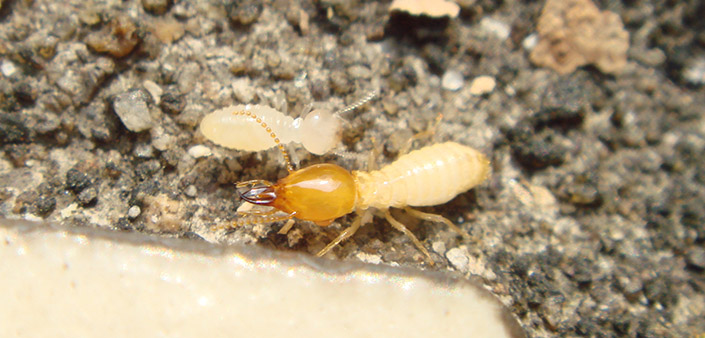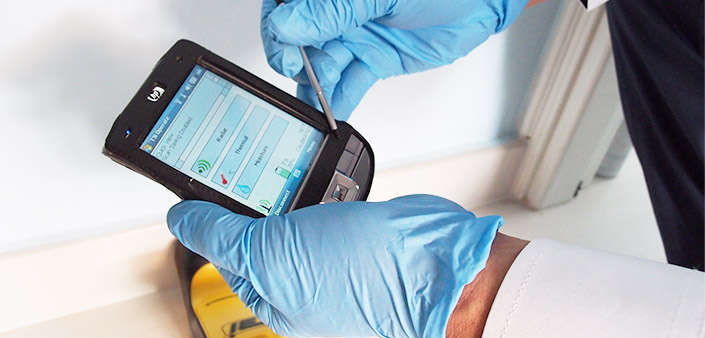Benefits of Using Our Service
- FLIR® Thermographic Camera Locates Monitoring termite activities
- Termatrac® T3i Termite Detecting Device Detects mud-leads, nests and entry points
- Video Borescope Monitors termite activities
Termites
The common termite species can be found in Taiwan is called Formosan subterranean termite (Coptotermes formosanus). The other two common genus within subterranean termite family (Rhinotermitidae) are Reticulitermes and Heterotermes. The group as a whole is so-named because their activities are usually associated to some extent with the soil.
Subterranean termites invade your premises mainly by two methods. The first one will be termite swarm during early spring, a swarmer is a reproductive individual within the colony. Other names for reproductive individuals are the terms queen and king. Swarmers emerge from the ground or soil and mate in flight. They then drop their wings. Males die after mating. When mated females find suitable habitats (with moisture and wood), they are then ready to begin laying eggs and forming a new colony.
The second method is that, subterranean termites access aboveground wood in buildings through protected cracks and cavities. Normally, termites live in colonies underground, from which they build tunnels in search of food, they are able to reach food above the ground level by building mud tubes (mud shelter), as long as they can find tiny cracks or wood, they may start invading your home.
Termites and Ants
Features
Termites colonies contain distinct types of castes (individuals) that differ in both form and function i.e. Reproductives, workers and soldiers. Termites shed their skin (molt) periodically in order to grow.
Termites can consume a wide assortment of cellulose foods including living and dead wood, roots, grass, paper, cardboard, fiberboard and other plant-based materials.
Mature colonies of Reticulitermes and Coptotermes are more likely to be decentralized entities occupying multiple nesting or foraging sites, interconnected by an extensive network of underground tunnels.
This is hard to quantify the size and foraging range of termites. A large colony contained about 1 – 7 million foragers and could travel distance up to 100 m. A small colony contained only 55,000 individuals and occupied foraging areas less than 20 meter square.
If you ask “How long termites have been infesting my structure?”, we can answer you only “They seem to have been there for a period of years.”.
The rate and extent of structural damage depends on many factors and conditions like food types, moisture content and also the amount of competing food sources, it is extremely hard to predict with confidence how long an infestation has been present. However, some studies show a large colony could consume 0.5 – 1 kg of wood each day.
Termites are small, white, tan, or black
Life Cycle
An infestation begins when a mated pair finds a suitable nesting site near or in wood and constructs a small chamber, which they enter and seal. Soon afterward, the female begins egg laying, and both the king and queen feed the young on predigested food until they are able to feed themselves. Most species of termites have microscopic, one-celled animals called protozoa within their intestines that help in converting wood (cellulose) into food for the colony.
Once workers and nymphs are produced, the king and queen are fed by the workers and cease feeding on wood. Termites go through incomplete metamorphosis with egg, nymph, and adult stages. Nymphs resemble adults but are smaller and are the most numerous stage in the colony. They also groom and feed one another and other colony members.
Common Types of Termite
Subterranean termites require moist environments. To satisfy this need, they usually nest in or near the soil and maintain some connection with the soil through tunnels in wood or through shelter tubes they construct. These shelter tubes are made of soil with bits of wood or even plasterboard (drywall).
Much of the damage they cause occurs in foundation and structural support wood. Because of the moisture requirements of subterranean termites, they are often found in wood that has wood rot or inside home, they are often found in wood floor, wood flames or wood furniture closed to restroom, bathroom, kitchen or window.
Controlling Subterranean Termites
Subterranean and dampwood termites in structures cannot be adequately controlled by fumigation, heat treatment, freezing, or termite electrocution devices because the reproductives and nymphs are concentrated in nests near or below ground level in structures out of reach of these control methods. The primary methods of controlling these termites are the application of termiticides or baiting programs.
Use of termiticides or baits should be supplemented with the destruction of their access points or nests. To facilitate control of subterranean termites, destroy their shelter tubes whenever possible to interrupt access to wooden substructures and to open colonies to attack from natural enemies such as ants.
Dampwood Termites
Dampwood termites only infest wood with high moisture content. Dampwood termites nest in wood buried in the ground, although contact with the ground is not necessary when infested wood is high in moisture. Because of their high moisture requirements, dampwood termites most often are found in cool, humid areas like flowerbeds and are typical pests of beach houses. Infestations in structures usually occur where wood is wetted by moisture leaks. Structures, utility poles, pilings, and lumber exposed to high moist soil and humidity are subject to attack.
Dampwood termites are noticeably larger than subterranean termites. Winged reproductives typically swarm between July and October, but it is not unusual to see them at other times of the year. Dampwood termite winged reproductives (sometimes called swarmers) are attracted to lights. Dampwood termites produce distinctive fecal pellets that are rounded at both ends, elongate, and lack the clear longitudinal ridges common to drywood termite pellets.
For dampwood termites, if infestations are small, destroy accessible nests by removing infested wood. Removing excess moisture from wood will also destroy dampwood termite nests.
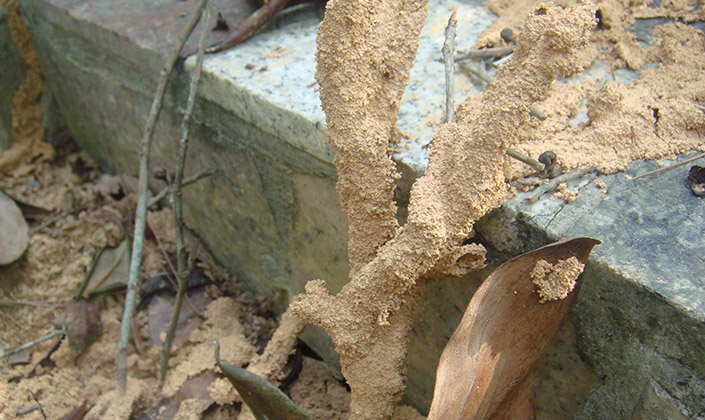
Drywood Termites
Drywood termites are so-named because they live entirely in dry, sound wood. They are well adapted to withstand environmental extremes in both moisture and temperature. Drywood termites colonies are small in comparison to subterranean termties, containing perhaps a few thousands individuals. Drywood termites infest dry, undecayed wood, including structural lumber as well as dead limbs of native trees and shade and orchard trees, utility poles, posts, and lumber in storage. From these areas, winged reproductives seasonally migrate to nearby buildings and other structures usually on sunny days during fall months.
Drywood termites have a low moisture requirement and can tolerate dry conditions for prolonged periods. They remain entirely above ground and do not connect their nests to the soil. Piles of their fecal pellets, which are distinctive in appearance, may be a clue to their presence. The fecal pellets are elongate (about 3/100 inch long) with rounded ends and have six flattened or roundly depressed surfaces separated by six longitudinal ridges.
Johnson Group Termite Control Service
Successful termite management requires many special skills, including a working knowledge of building construction. An understanding of termite biology and identification can help a homeowner detect problems and understand methods of control. In most cases it is advisable to hire a professional pest control company to carry out the inspection and control program.
Management techniques vary depending on the species causing an infestation. Multiple colonies of the same species of termite or more than one species of termite can infest a building. Any of these variables will influence your control approach.
Johnson Group delivers the world’s best value in termite control. You’ll receive written specifications, an inspection report and customized treatment programs after your consultation/inspection.
Benefits
- Eliminate existing termite colonies by either liquid termiticides or termite baits, or combinations of both
- Protect wood made items from termite attack
- Create an effective barrier and protective zone from future invasion
Johnson Group Termite Management Systems – equips the most innovative and exclusive technology in termite management. We introduce FLIR® Thermographic Camera for Termite Activity Diagnostics; Termatrac® T3i (Termite Detector); and Borescope Termite Inspection as a standard inspection & treatment tools and requires no additional costs from you.

FLIR® Thermographic Camera
Locating termite activities
Thermographic Termite Inspection – Infrared thermography is the easiest and quickest method to detect heat and moisture in structures or buildings. An infrared camera shows exactly where the problems are and helps focus termite professionals’ attention allowing them to properly diagnose areas with termite activity.
Thermal Camera helps our professionals quickly scan large areas to pinpoint
- water intrusion, find moisture beneath the surfaces
- mud tubes (mud shelters)
- nesting locations
Termatrac® T3i – Termite Detector
Detecting mud-leads, nests and entry points
- Termatrac’s latest patented Termite Detection Radar
- Advanced Remote Thermal Sensor with Laser Guide
- Advanced Moisture Sensor
The 3-in-1 functionality makes the Termatrac® T3i become one of the best available tools for our Professionals.
Termite risk areas are easily identified using the Remote Thermal Sensor with Laser Guide and/or the built in Moisture Sensor. Termatrac’s patented Termite Detection Radar is then used to accurately detect, confirm and track the presence of termites, plus precisely locate nests, mud-leads, and entry points to ensure a cost-efficient and effective treatment.
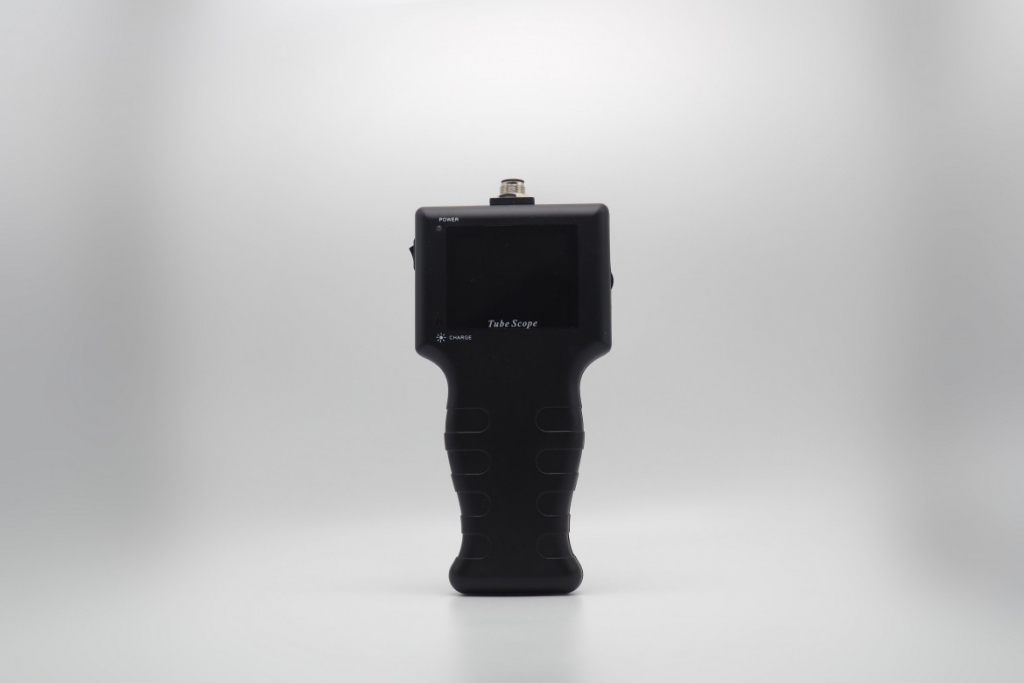
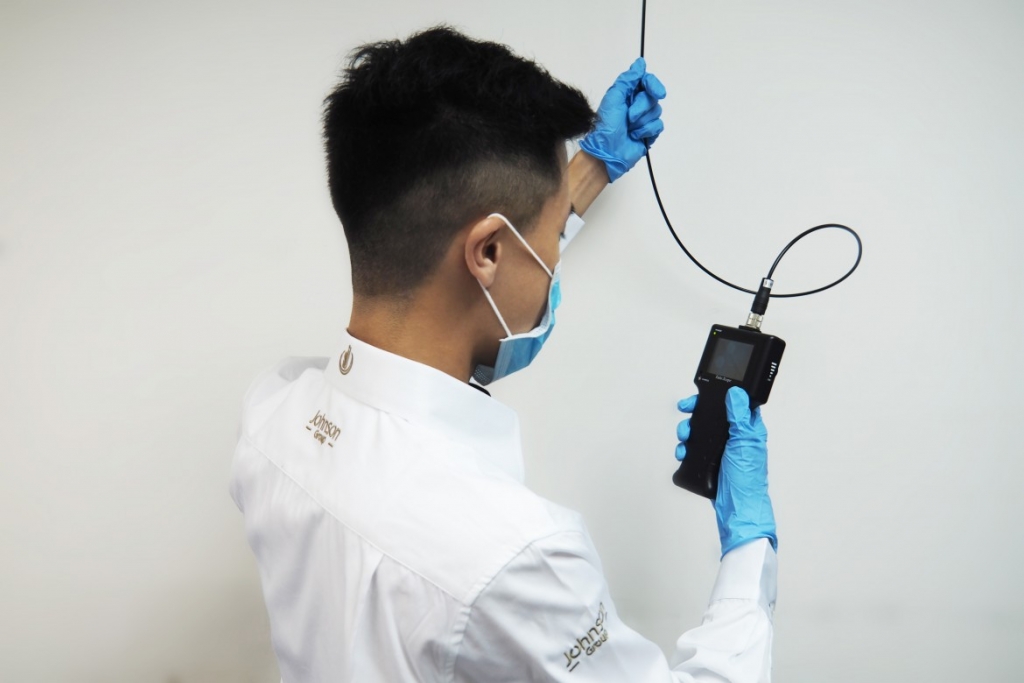
SafePRO® Borescope
Monitoring termite activities
SafePRO® Borescope enables our technicians to see into areas that are otherwise inaccessible for visual inspection. The palm-sized video borescope is equipped with an LED light source, TFT display, camera and recorder, it can let you see through what is actually moving underneath the mud shelters and behind finished walls. Typically, a hole (~5mm) is drilled and the optical lens is inserted into the desired viewing areas.


